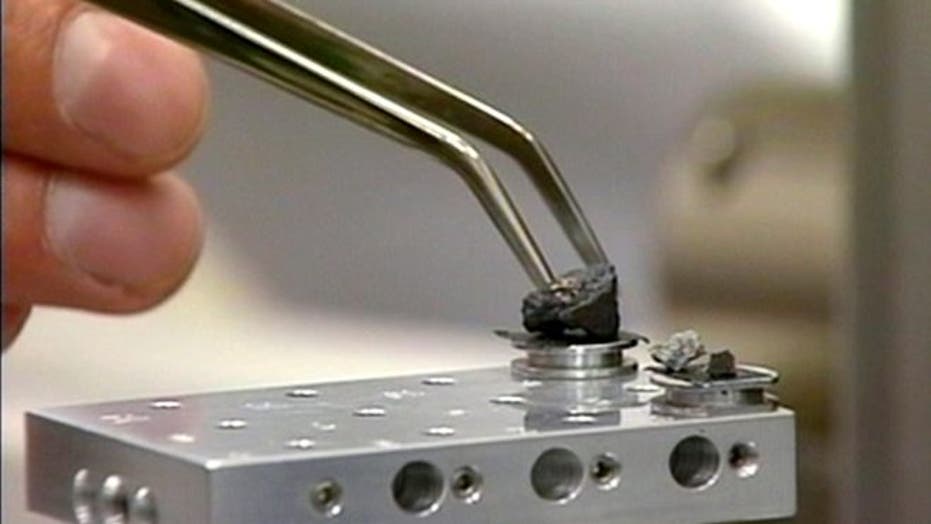Tiny fragments of the meteorite that blew apart over Russia may be worth more than their weight in gold.
Amateur enthusiasts and scientists alike are scrambling to find bits of the meteorite that streaked across the morning sky over the Russian city of Chelyabinsk Friday at a hypersonic speed of at least 33,000 mph and shattered into pieces about 18-32 miles above the ground.
Hundreds were injured following a sonic blast that shattered windows, but scattered amid the broken glass are bits of space rock -- and enthusiasts will pay dearly for them, said Dmitry Kachkalin, a member of the Russian Society of Amateur Meteorite Lovers.
“The price is hard to say yet ... The fewer meteorites that are recovered, the higher their price,'' Kachkalin told Reuters. He estimates that chunks could be worth up to $2,200 per gram -- more than 40 times the current cost of gold, the news agency said.
[pullquote]
- Asteroid 2012 DA14: 5 Surprising Facts About Friday’s Earth Flyby
- About 1,100 injured as meteorite hits Russia with force of atomic bomb
- Fire in the sky: Nearly 1,100 injured as meteor falls in Russia
- Earth-buzzing asteroid worth $195 billion, space miners say
- Russian meteor blast ‘heard’ around the world
- Russian meteor blast recalls massive 1908 ‘Tunguska event’
- Russian meteorite: Why didn’t scientists see it coming?
Russian scientists on Monday said they had recovered as many as 53 tiny fragments of rock on the ice covering Russia’s Lake Chebarkul -- 0.2-inch-long bits of the 2-foot-wide meteorite that blasted through heavens and left a circular hole on Friday.
“The fragments we have found are traces of the outer layer of the meteorite – there is a melted crust and so forth – which means that the basic mass lies there, in the lake,” Viktor Grokhovsky, a member of the Russian Academy of Science’s committee on meteorites, told the Interfax news service.
Did they check eBay first? Within hours of the explosion, residents of Chelyabinsk had listed bits of the space rock on classified ads sites.
According to the International Business Times, a user named Andrew advertised 18 pieces of the “meteor from the news,” for 500 rubles each (the equivalent of $16.61) on Avito.Ru, a Russian-language classified ads site.
“There are 18 pieces of size as a wristwatch,” Andrew wrote in Russian on the site. “You can choose as souvenirs or for stories. BOOK ME IN ADVANCE, to snap up FAST!”
Another user felt his rocks were more worthy, asking 300,000 rubles (roughly $10,000) for a piece of the rock. “A piece of the meteor for sale, it’s new,” Sergey wrote, with a photo of himself holding a piece of stone.
The first fragments from Friday’s meteor are mainly stone, made up of about 10 percent iron, Grokhovsky said. More esoteric minerals such as platinum and gold are said to be part of other asteroids, however.
But to meteor hunters, the tiny bits of rock are priceless, whatever they may contain.
The fireball that streaked into the sky over this tough industrial city at about sunrise Friday was undeniably traumatic. Nearly 1,200 people were reported injured by the shock wave from the explosion, estimated to be as strong as 20 Hiroshima atomic bombs.
But it also brought a sense of cooperation in a troubled region. Large numbers of volunteers came forward to help fix the damage caused by the explosion and many residents came together on the Internet -- first to find out what happened and soon to make jokes.
Chelyabinsk, nicknamed Tankograd because it produced the famed Soviet T-34 tanks, can be as grim as its backbone-heavy industries. Long winters where temperatures routinely hit minus-22 Fahrenheit add to a general dour mien, as do worries about dangerous facilities in the surrounding region.
In 1957, a waste tank at the Mayak nuclear weapons plant in the Chelyabinsk region exploded, contaminating 9,200 square miles and prompting authorities to evacuate 10,000 nearby residents. It is now Russia's main nuclear waste disposal facility. A vast plant for disposing of chemical weapons lies 50 miles east of the city.
"The city is a place where people always seem bitter with each other," said music teacher Ilya Shibanov. But the meteor "was one of the rare times when people started to live together through one event."
"For most people, it's a good excuse for a joke," he said.
The Associated Press contributed to this report.

